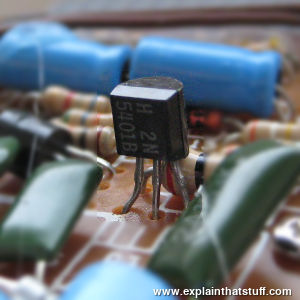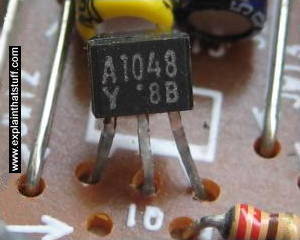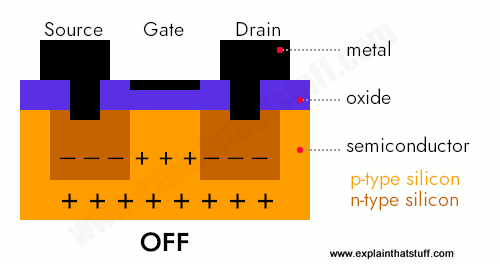
Transistors
by Chris Woodford. Last updated: September 26, 2024.
Your brain contains around 100 billion cells called neurons—the tiny switches that let you think and remember things. Computers contain billions of miniature "brain cells" as well. They're called transistors and they're made from silicon, a chemical element commonly found in sand. Transistors have revolutionized electronics since they were first invented over half a century ago by John Bardeen, Walter Brattain, and William Shockley. But what are they—and how do they work?
Photo: An insect with three legs? No, a typical transistor on an electronic circuit board. Although simple circuits contain individual transistors like this, complex circuits inside computers also contain microchips, which might have 50 billion transistors or more packed inside! (Technically, if you're interested in the more geeky bits, this is a 5401B silicon PNP amplifier transistor. I'll explain what all that stuff means in a moment.)
Sponsored links
Contents
What does a transistor actually do?

Photo: A closer look at the 5401B.
A transistor is really simple—and really complex. Let's start with the simple part. A transistor is a miniature electronic component that can do two different jobs. It can work either as an amplifier or a switch:
When it works as an amplifier, it takes in a tiny electric current at one end (an input current) and produces a much bigger electric current (an output current) at the other. In other words, it's a kind of current booster. That comes in really useful in things like hearing aids, one of the first things people used transistors for. A hearing aid has a tiny microphone in it that picks up sounds from the world around you and turns them into fluctuating electric currents. These are fed into a transistor that boosts them and powers a tiny loudspeaker, so you hear a much louder version of the sounds around you. William Shockley, one of the inventors of the transistor, once explained transistor-amplifiers to a student in a more humorous way: "If you take a bale of hay and tie it to the tail of a mule and then strike a match and set the bale of hay on fire, and if you then compare the energy expended shortly thereafter by the mule with the energy expended by yourself in the striking of the match, you will understand the concept of amplification." [1]
Transistors can also work as switches. A tiny electric current flowing through one part of a transistor can make a much bigger current flow through another part of it. In other words, the small current switches on the larger one. This is essentially how all computer chips work. For example, a memory chip contains hundreds of millions or even billions of transistors, each of which can be switched on or off individually. Since each transistor can be in two distinct states, it can store two different numbers, zero and one. With billions of transistors, a chip can store billions of zeros and ones, and almost as many ordinary numbers and letters (or characters, as we call them). More about this in a moment.

Photo: Compact hearing aids were among the first applications for transistors—and this one dates from about the late 1950s or 1960s. About the size of a pack of playing cards, it was designed to be worn in or on a jacket pocket. There's a microphone on the other side of the case that picks up ambient sounds. You can clearly see the four little black transistors inside, amplifying those sounds and then shooting them out to the little loudspeaker (bottom) that sits in your ear. [2]
The great thing about old-style machines was that you could take them apart to figure out how they worked. It was never too hard, with a bit of pushing and poking, to discover which bit did what and how one thing led to another. But electronics is entirely different. It's all about using electrons to control electricity. An electron is a minute particle inside an atom. It's so small, it weighs just under 0.000000000000000000000000000001 kg! The most advanced transistors work by controlling the movements of individual electrons, so you can imagine just how small they are. In a modern computer chip, the size of a fingernail, you'll probably find between half a billion (500 million) and 50 billion separate transistors. There's no chance of taking a transistor apart to find out how it works, so we have to understand it with theory and imagination instead. First off, it helps if we know what a transistor is made from.
How is a transistor made?
Transistors are made from silicon, a chemical element found in sand, which does not normally conduct electricity (it doesn't allow electrons to flow through it easily). Silicon is a semiconductor, which means it's neither really a conductor (something like a metal that lets electricity flow) nor an insulator (something like plastic that stops electricity flowing). If we treat silicon with impurities (a process known as doping), we can make it behave in a different way. If we dope silicon with the chemical elements arsenic, phosphorus, or antimony, the silicon gains some extra "free" electrons—ones that can carry an electric current—so electrons will flow out of it more naturally. Because electrons have a negative charge, silicon treated this way is called n-type (negative type). We can also dope silicon with other impurities such as boron, gallium, and aluminum. Silicon treated this way has fewer of those "free" electrons, so the electrons in nearby materials will tend to flow into it. We call this sort of silicon p-type (positive type).
![]()
Photo: A wafer of silicon. Photo by courtesy of NASA Glenn Research Center (NASA-GRC) and Internet Archive.
Quickly, in passing, it's important to note that neither n-type or p-type silicon actually has a charge in itself: both are electrically neutral. It's true that n-type silicon has extra "free" electrons that increase its conductivity, while p-type silicon has fewer of those free electrons, which helps to increase its conductivity in the opposite way. In each case, the extra conductivity comes from having added neutral (uncharged) atoms of impurities to silicon that was neutral to start with—and we can't create electrical charges out of thin air! A more detailed explanation would need me to introduce an idea called band theory, which is a little bit beyond the scope of this article. All we need to remember is that "extra electrons" means extra free electrons—ones that can freely move about and help to carry an electric current.
Silicon sandwiches
We now have two different types of silicon. If we put them together in layers, making sandwiches of p-type and n-type material, we can make different kinds of electronic components that work in all kinds of ways.

Artwork: Join n-type silicon to p-type silicon and you get an n-p junction, which is the basis of diodes and transistors.
Suppose we join a piece of n-type silicon to a piece of p-type silicon and put electrical contacts on either side. Exciting and useful things start to happen at the junction between the two materials. If we turn on the current, we can make electrons flow through the junction from the n-type side to the p-type side and out through the circuit. This happens because the lack of electrons on the p-type side of the junction pulls electrons over from the n-type side and vice-versa. But if we reverse the current, the electrons won't flow at all. What we've made here is called a diode (or rectifier). It's an electronic component that lets current flow through it in only one direction. It's useful if you want to turn alternating (two-way) electric current into direct (one-way) current. Diodes can also be made so they give off light when electricity flows through them. You might have seen these light-emitting diodes (LEDs) on pocket calculators and electronic displays on hi-fi stereo equipment.
Sponsored links
How a junction transistor works

Photo: A typical silicon PNP transistor (an A1048 designed as an audio-frequency amplifier).
Now suppose we use three layers of silicon in our sandwich instead of two. We can either make a p-n-p sandwich (with a slice of n-type silicon as the filling between two slices of p-type) or an n-p-n sandwich (with the p-type in between the two slabs of n-type). If we join electrical contacts to all three layers of the sandwich, we can make a component that will either amplify a current or switch it on or off—in other words, a transistor. Let's see how it works in the case of an n-p-n transistor.
So we know what we're talking about, let's give names to the three electrical contacts. We'll call the two contacts joined to the two pieces of n-type silicon the emitter and the collector, and the contact joined to the p-type silicon we'll call the base. When no current is flowing in the transistor, we know the p-type silicon is short of electrons (shown here by the little plus signs, representing positive charges) and the two pieces of n-type silicon have extra electrons (shown by the little minus signs, representing negative charges).

Another way of looking at this is to say that while the n-type has a surplus of electrons, the p-type has holes where electrons should be. Normally, the holes in the base act like a barrier, preventing any significant current flow from the emitter to the collector while the transistor is in its "off" state.
A transistor works when the electrons and the holes start moving
across the two junctions between the n-type and p-type silicon.
Let's connect the transistor up to some power. Suppose we attach a small positive voltage to the base, make the emitter negatively charged, and make the collector positively charged. Electrons are pulled from the emitter into the base—and then from the base into the collector. And the transistor switches to its "on" state:

The small current that we turn on at the base makes a big current flow between the emitter and the collector. By turning a small input current into a large output current, the transistor acts like an amplifier. But it also acts like a switch at the same time. When there is no current to the base, little or no current flows between the collector and the emitter. Turn on the base current and a big current flows. So the base current switches the whole transistor on and off. Technically, this type of transistor is called bipolar because two different kinds (or "polarities") of electrical charge (negative electrons and positive holes) are involved in making the current flow.
We can also understand a transistor by thinking of it like a pair of diodes. With the base positive and the emitter negative, the base-emitter junction is like a forward-biased diode, with electrons moving in one direction across the junction (from left to right in the diagram) and holes going the opposite way (from right to left). The base-collector junction is like a reverse-biased diode. The positive voltage of the collector pulls most of the electrons through and into the outside circuit (though some electrons do recombine with holes in the base).
How a field-effect transistor (FET) works
All transistors work by controlling the movement of electrons, but not all of them do it the same way. Like a junction transistor, a FET (field effect transistor) has three different terminals—but they have the names source (analogous to the emitter), drain (analogous to the collector), and gate (analogous to the base). In a FET, the layers of n-type and p-type silicon are arranged in a slightly different way and coated with layers of metal and oxide. That gives us a device called a MOSFET (Metal Oxide Semiconductor Field Effect Transistor).

Although there are extra electrons in the n-type source and drain, they cannot flow from one to the other because of the holes in the p-type gate in between them. However, if we attach a positive voltage to the gate, an electric field is created there that allows electrons to flow in a thin channel from the source to the drain. This "field effect" allows a current to flow and switches the transistor on:

For the sake of completeness, we could note that a MOSFET is a unipolar transistor because only one kind ("polarity") of electric charge is involved in making it work.
Sponsored links
How do transistors work in calculators and computers?
In practice, you don't need to know any of this stuff about electrons and holes unless you're going to design computer chips for a living! All you need to know is that a transistor works like an amplifier or a switch, using a small current to switch on a larger one. But there's one other thing worth knowing: how does all this help computers store information and make decisions?
We can put a few transistor switches together to make something called a logic gate, which compares several input currents and gives a different output as a result. Logic gates let computers make very simple decisions using a mathematical technique called Boolean algebra. Your brain makes decisions the same way. For example, using "inputs" (things you know) about the weather and what you have in your hallway, you can make a decision like this: "If it's raining AND I have an umbrella, I will go to the shops". That's an example of Boolean algebra using what's called an AND "operator" (the word operator is just a bit of mathematical jargon to make things seem more complicated than they really are). You can make similar decisions with other operators. "If it's windy OR it's snowing, then I will put on a coat" is an example of using an OR operator. Or how about "If it's raining AND I have an umbrella OR I have a coat then it's okay to go out". Using AND, OR, and other operators called NOR, XOR, NOT, and NAND, computers can add up or compare binary numbers. That idea is the foundation stone of computer programs: the logical series of instructions that make computers do things.
Normally, a junction transistor is "off" when there is no base current and switches to "on" when the base current flows. That means it takes an electric current to switch the transistor on or off. But transistors like this can be hooked up with logic gates so their output connections feed back into their inputs. The transistor then stays on even when the base current is removed. Each time a new base current flows, the transistor "flips" on or off. It remains in one of those stable states (either on or off) until another current comes along and flips it the other way. This kind of arrangement is known as a flip-flop and it turns a transistor into a simple memory device that stores a zero (when it's off) or a one (when it's on). Flip-flops are the basic technology behind computer memory chips.


